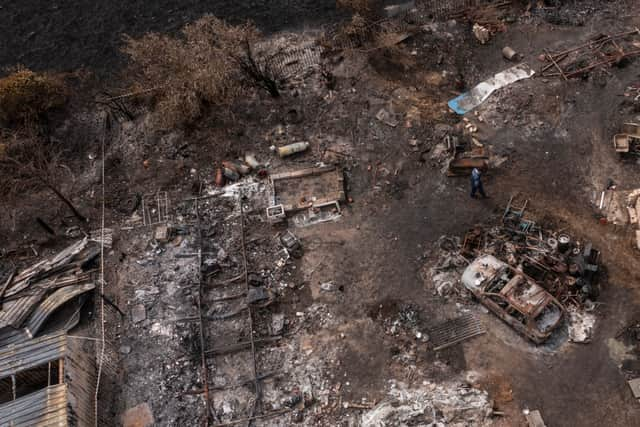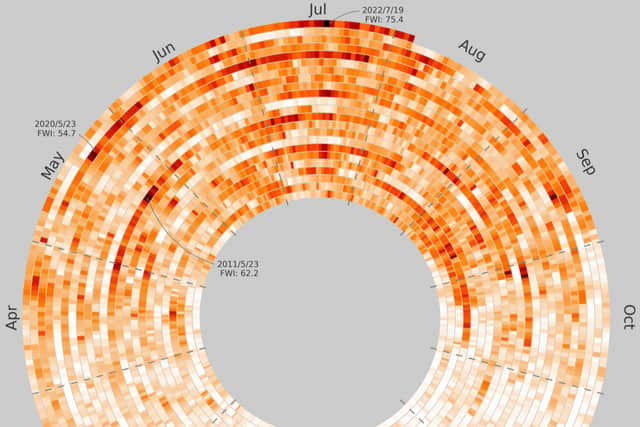Record temperatures and dry weather ramping up risk of wildfires, research led by Manchester academic finds
and live on Freeview channel 276
This year’s record-breaking temperatures and exceptionally dry weather is putting the UK at unprecedented risk of wildfires breaking out, research led by an academic at The University of Manchester has found.
The UK Fire Danger Rating System project team, which is led by Dr Gareth Clay from The University of Manchester, says the fire weather index has reached record levels this summer.
Advertisement
Hide AdAdvertisement
Hide AdTemperatures reached above 40C in parts of the country during a heatwave recently, when Manchester looks likely to have experienced its hottest day on record.
And with further hot, dry spells to come before the summer is over the experts are warning that the danger of wildfires in 2022 is far from over. In addition, ongoing climate change means we should expect higher levels of fire risks more frequently in future, the academics say.
What has the research team found?
The team, which includes experts from the University of Birmingham, University of Exeter, Swansea University, London School of Economics, Portsmouth University and Forest Research, looked at the index which measures the likelihood of extreme fires breaking out.
They found that on 19 July this reached its highest level since records began in 1979. This was the day in which there were a number of devastating fires in England, with grasslands and arable lanes close to densely-populated areas going up in flames and some houses being completely destroyed.
Advertisement
Hide AdAdvertisement
Hide Ad

The team says in some areas vegetation was so dry that the usual scales of measurement could not be used, and noted with concern that the fires happened mainly in areas where people were sheltering from the record heatwave in homes or gardens.
By contrast, more remote rural areas, where moorland fires can be seen in hot, dry summers, saw fewer incidents when temperatures reached record highs. The academics suggest anecdotal evidence indicates this could be because fewer people were out and about due to it simply being too hot.
The index is calculated from long-term and short-term weather measurements, including temperature, relative humidity, rainfall and wind strength.
Why has this research been done and what action do the academics think should be taken now?
The academics say the fire risk this summer is not over, with further periods of hot, dry weather forecast.
Advertisement
Hide AdAdvertisement
Hide AdAnd these unprecedented fire weather and extreme fuel moisture conditions are expected to occur more frequently in the coming decades driven by human-caused climate change,the researchers say.
While this year’s worst fires were seen around London and the South East of England the researchers say incidents in recent years in Greater Manchester on Saddleworth Moor and Winter Hill in Bolton have brought the issue to attention locally as well.
Dr Clay said: “The Met Office provide a Fire Severity Index (FSI) - an assessment of how severe a fire could become if one were to start - but this does not provide an assessment of the risk of wildfires occurring.
“To fill this critical gap, our project team are researching the key components that allows the building of an effective, tailored fire danger rating system that can establish the likelihood and impact of wildfires in the country.
Advertisement
Hide AdAdvertisement
Hide Ad“Climate change is going to lead to extend our wildfire season across the UK with longer, drier periods in the summer months, particularly in the south but also in our neck of the woods around Manchester.


“Fire weather is just one part of the equation. There’s also fuel, whether vegetation is ready and able to burn and flammable, and ignition sources. Most fires are caused by people, whether accidental or deliberate. We’re trying to better understand all these different components.”
The researchers also say there is a lot that can be done to reduce the likelihood of really damaging wildfires breaking out.
Professor Claire Belcher, of the University of Exeter, said: “Major retailers stopping the sale of disposable barbeques in some regions is one welcome contribution to reducing accidental ignitions, but with the dry hot weather currently continuing in parts of the UK, the overall fire risk remains very high.”
Advertisement
Hide AdAdvertisement
Hide AdDr Clay added: “It’s about exercising caution and being careful in the countryside, so if you’re going for a walk on the moors take a picnic rather than a disposable barbecue. Also, having barbecues in the garden when there’s a high fire risk could be problematic.
“If you’re working with motorised equipment that’s hot it could need to be on hardstanding rather than next to tinder-dry grass. It’s about telling people at times of high-fire weather that if a fire started it could become quite problematic.”
Comment Guidelines
National World encourages reader discussion on our stories. User feedback, insights and back-and-forth exchanges add a rich layer of context to reporting. Please review our Community Guidelines before commenting.
